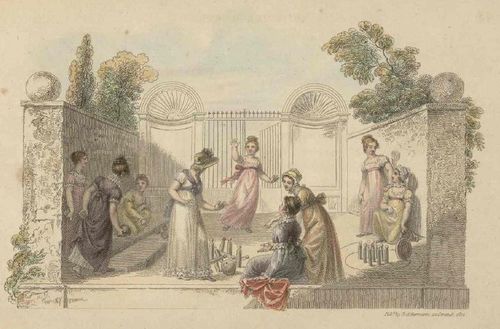Annotation:Nine Pins (1): Difference between revisions
No edit summary |
No edit summary |
||
| Line 2: | Line 2: | ||
{{TuneAnnotation | {{TuneAnnotation | ||
|f_tune_annotation_title= https://tunearch.org/wiki/Annotation:Nine_Pins_(1) > | |f_tune_annotation_title= https://tunearch.org/wiki/Annotation:Nine_Pins_(1) > | ||
|f_annotation='''NINE-PINS (NINEPINS) [1].''' AKA - "Ninepins (1)." AKA and see "[[Cats in the Village]]," "[[French Reaper (The)]]," "[[Flying Boy (The)]]," "[[Garçon Volage Quadrille (1) (La)]]," "[[Jim Crow Quadrille (3)]]," "[[Lea Castle]]," "[[Quadrille 2nd Set – La Poule]]," "[[Queen Victoria's Country Dance]]," "[[Turfahun Barndance (The)]]." English, Jig (6/8 time). G Major. Standard tuning (fiddle). ABC. Ninepins is a game similar to bowling, and although there are various rules and procedures for the game, it is generally played with hand-sized balls and a set of nine slender pins arranged in a diamond pattern. The game was popular in Europe for several hundred years before being imported to the New World in the 1600's where it was a favorite with early Dutch and German settlers. Ninepins could even be found in Puritan communities despite the elders' consistent objections to such pleasurable activities. The game of ninepins was a popular betting game, too popular for some lawmakers, who outlawed the game in Connecticut and New York in the early 19th century. | |f_annotation='''NINE-PINS (NINEPINS) [1].''' AKA - "Ninepins (1)." AKA and see "[[Cats in the Village]]," "[[French Reaper (The)]]," "[[Flying Boy (The)]]," "[[Garçon Volage Quadrille (1) (La)]]," "[[Jim Crow Quadrille (3)]]," "[[Lea Castle]]," "[[Petite Bijoux (Les)]]," "[[Quadrille 2nd Set – La Poule]]," "[[Queen Victoria's Country Dance]]," "[[Turfahun Barndance (The)]]." English, Jig (6/8 time). G Major. Standard tuning (fiddle). ABC. Ninepins is a game similar to bowling, and although there are various rules and procedures for the game, it is generally played with hand-sized balls and a set of nine slender pins arranged in a diamond pattern. The game was popular in Europe for several hundred years before being imported to the New World in the 1600's where it was a favorite with early Dutch and German settlers. Ninepins could even be found in Puritan communities despite the elders' consistent objections to such pleasurable activities. The game of ninepins was a popular betting game, too popular for some lawmakers, who outlawed the game in Connecticut and New York in the early 19th century. | ||
<br> | <br> | ||
<Br> | <Br> | ||
Latest revision as of 01:08, 23 March 2024
X:198 T:Cats In The Village. FTB.198 T:Ninepins. FTB.198 T:Flying Boy,The,aka. FTB.198 M:6/8 L:1/8 Q:120 R:.Jig O:England Z:Chris Partington K:G (B/c/)|d^cde2d|BcBd2c|A2A AGA|B3G2(B/c/)| d^cde2d|B2Bd2c|A2A AGA|G3-G2|| g|fed def|g3d2B|cec BdB|A2AA2g| fed def|g3efg|aba gfe|ded cBA| |"if required"e2eg2g|fefB2B|c2AF2B|G3E2B| e2eg2g|fefB2B|c2AF2B|E3-E2|]
NINE-PINS (NINEPINS) [1]. AKA - "Ninepins (1)." AKA and see "Cats in the Village," "French Reaper (The)," "Flying Boy (The)," "Garçon Volage Quadrille (1) (La)," "Jim Crow Quadrille (3)," "Lea Castle," "Petite Bijoux (Les)," "Quadrille 2nd Set – La Poule," "Queen Victoria's Country Dance," "Turfahun Barndance (The)." English, Jig (6/8 time). G Major. Standard tuning (fiddle). ABC. Ninepins is a game similar to bowling, and although there are various rules and procedures for the game, it is generally played with hand-sized balls and a set of nine slender pins arranged in a diamond pattern. The game was popular in Europe for several hundred years before being imported to the New World in the 1600's where it was a favorite with early Dutch and German settlers. Ninepins could even be found in Puritan communities despite the elders' consistent objections to such pleasurable activities. The game of ninepins was a popular betting game, too popular for some lawmakers, who outlawed the game in Connecticut and New York in the early 19th century.
The tune belongs to a large family of tunes under various titles (with no particular one prominent) that were popular in Britain and Ireland from the mid-19th century, surviving into the 20th century (particularly as the first strain of "Dingle Regatta"). The melody was often used as a quadrille part, again, under various titles.


